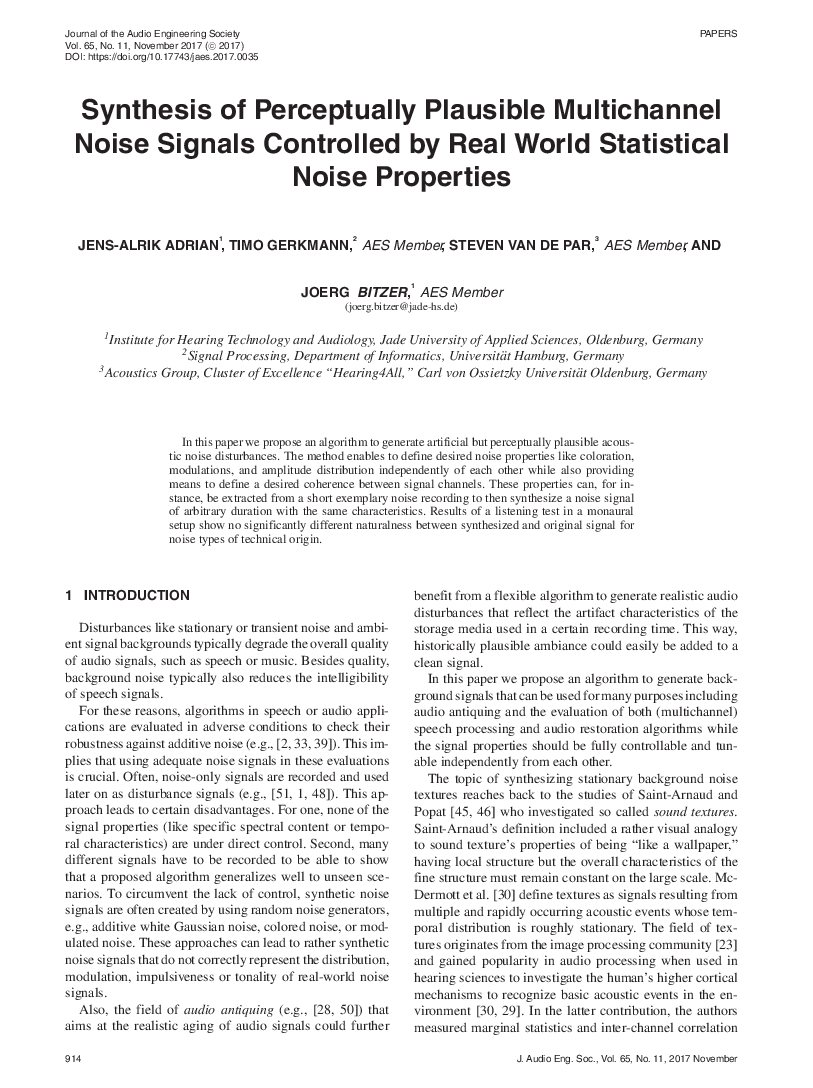Home / Publications / E-library page
You are currently logged in as an
Institutional Subscriber.
If you would like to logout,
please click on the button below.
Home / Publications / E-library page
Only AES members and Institutional Journal Subscribers can download
Algorithms in speech and audio applications are often evaluated under adverse conditions to evaluate their robustness against additive noise. This research describes a method to generate artificial but perceptually plausible acoustic disturbances, thereby providing a controlled and repeatable context for evaluating algorithms. This allows for control of such noise parameters as coloration, modulation, and amplitude distribution independently of each other, while also providing the means to define the amount of coherence among all the signal channels. Results of a listening test in a monaural setup show no significant difference in naturalness between synthesized and original signal. It is not always obvious how to create natural noise. For example, it was observed that white Gaussian noise is often an inappropriate noise. Frequency-dependent modulations on a short time scale appear to contribute to naturalness. Synthesizing vinyl/shellac, which has a particular type of impulse character, requires a unique approach to synthesis. Rain and applause synthesis proved to be challenging.
Author (s): Adrian, Jens-Alrik; Gerkmann, Timo; van de Par, Steven; Bitzer, Joerg
Affiliation:
Institute for Hearing Technology and Audiology, Jade University of Applied Sciences, Oldenburg, Germany; Signal Processing, Department of Informatics, Universität Hamburg, Germany; Acoustics Group, Cluster of Excellence
(See document for exact affiliation information.)
Publication Date:
2017-11-06
Import into BibTeX
Permalink: https://aes2.org/publications/elibrary-page/?id=19360
(691KB)
Click to purchase paper as a non-member or login as an AES member. If your company or school subscribes to the E-Library then switch to the institutional version. If you are not an AES member Join the AES. If you need to check your member status, login to the Member Portal.

Adrian, Jens-Alrik; Gerkmann, Timo; van de Par, Steven; Bitzer, Joerg; 2017; Synthesis of Perceptually Plausible Multichannel Noise Signals Controlled by Real World Statistical Noise Properties [PDF]; Institute for Hearing Technology and Audiology, Jade University of Applied Sciences, Oldenburg, Germany; Signal Processing, Department of Informatics, Universität Hamburg, Germany; Acoustics Group, Cluster of Excellence; Paper ; Available from: https://aes2.org/publications/elibrary-page/?id=19360
Adrian, Jens-Alrik; Gerkmann, Timo; van de Par, Steven; Bitzer, Joerg; Synthesis of Perceptually Plausible Multichannel Noise Signals Controlled by Real World Statistical Noise Properties [PDF]; Institute for Hearing Technology and Audiology, Jade University of Applied Sciences, Oldenburg, Germany; Signal Processing, Department of Informatics, Universität Hamburg, Germany; Acoustics Group, Cluster of Excellence; Paper ; 2017 Available: https://aes2.org/publications/elibrary-page/?id=19360
@article{adrian2017synthesis,
author={adrian jens-alrik and gerkmann timo and van de par steven and bitzer joerg},
journal={journal of the audio engineering society},
title={synthesis of perceptually plausible multichannel noise signals controlled by real world statistical noise properties},
year={2017},
volume={65},
issue={11},
pages={914-928},
month={november},}
TY – paper
TI – Synthesis of Perceptually Plausible Multichannel Noise Signals Controlled by Real World Statistical Noise Properties
SP – 914 EP – 928
AU – Adrian, Jens-Alrik
AU – Gerkmann, Timo
AU – van de Par, Steven
AU – Bitzer, Joerg
PY – 2017
JO – Journal of the Audio Engineering Society
VO – 65
IS – 11
Y1 – November 2017